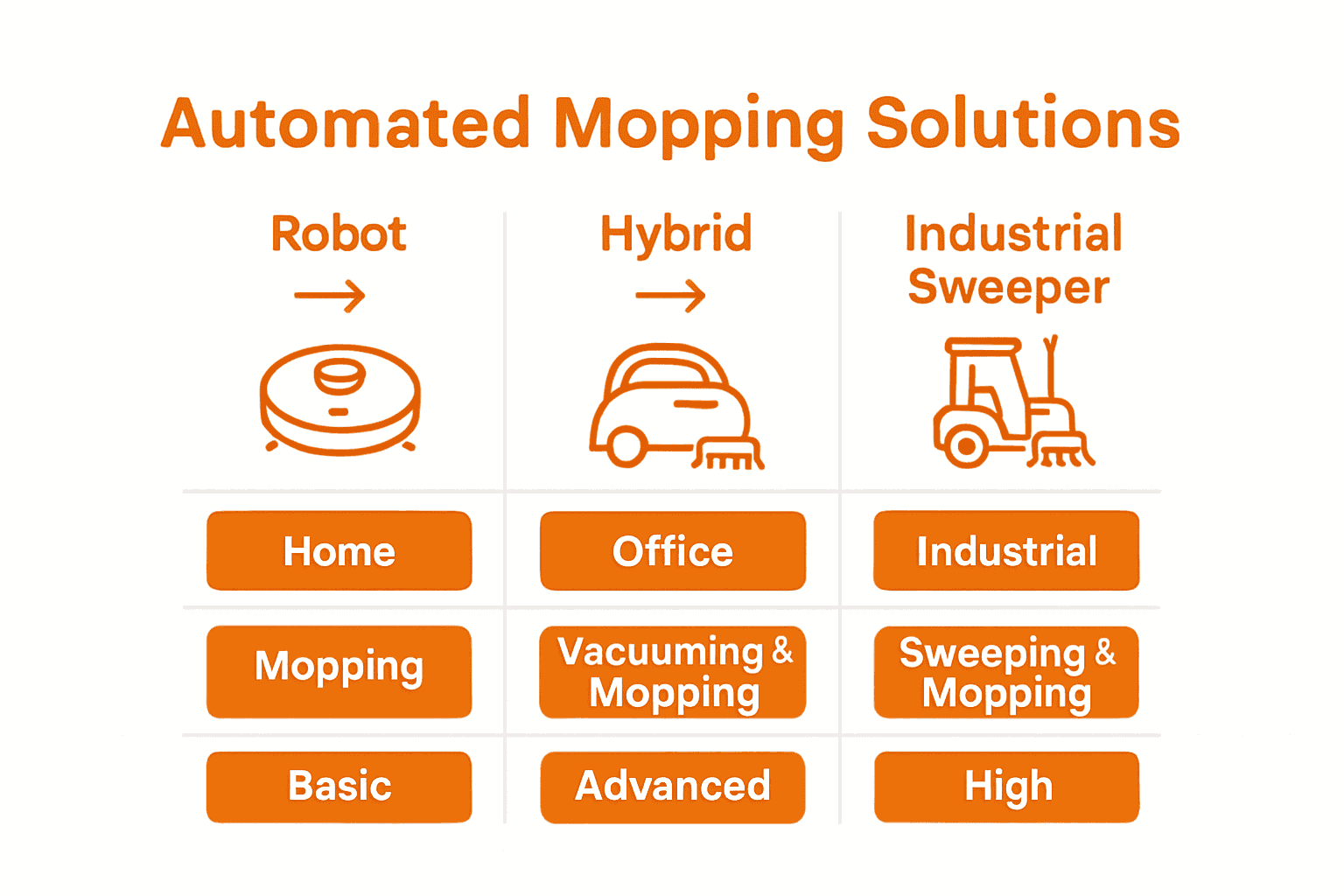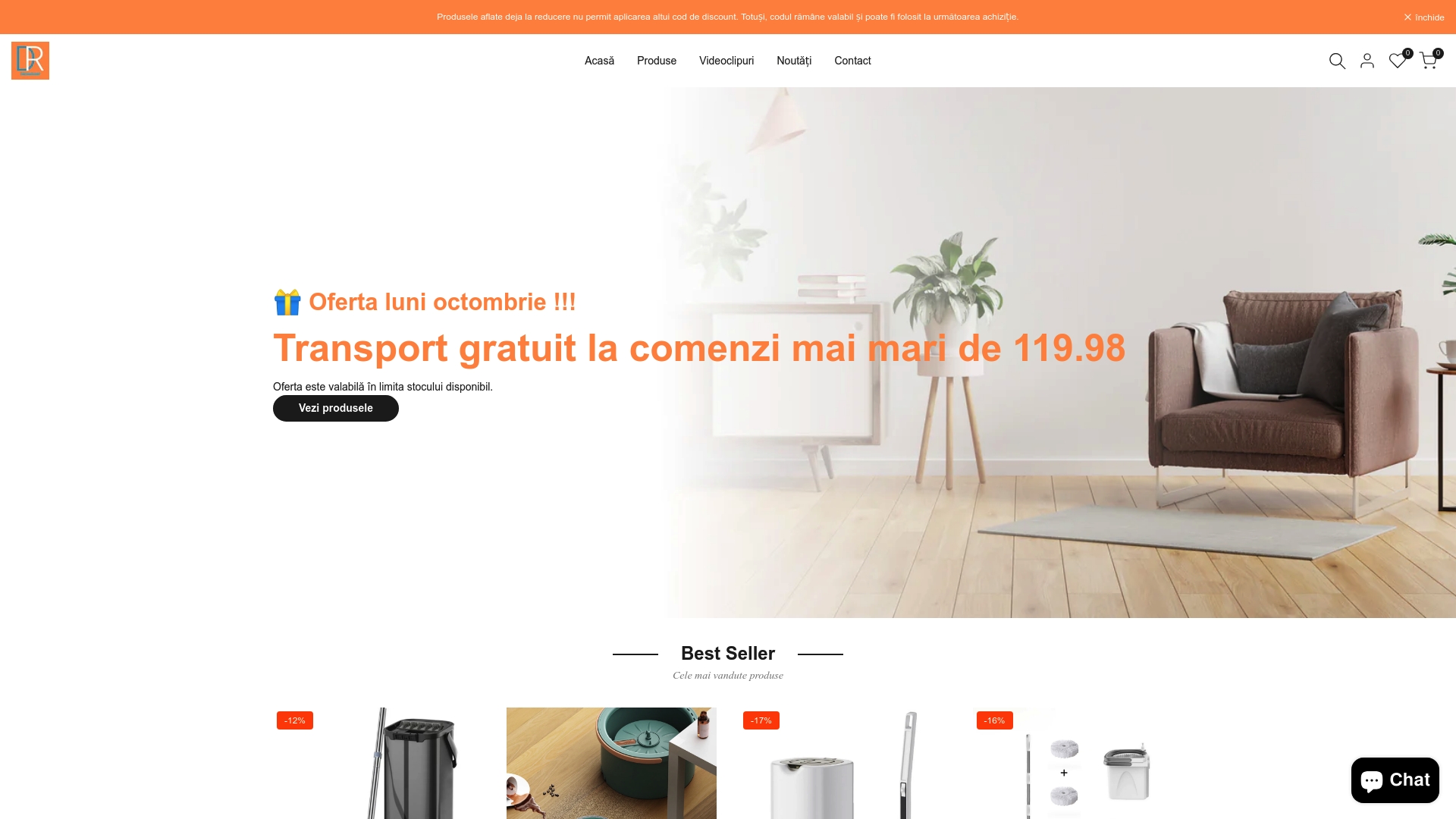Nearly one in three households now use some form of cleaning automation, marking a major shift in how we tackle everyday chores. Smart mopping technology has changed what people expect from both home and commercial cleaning. With robots that can learn floor layouts and adjust to different surfaces, cleaning has become smarter, safer, and more reliable than ever. This guide highlights the cutting-edge features and practical benefits that put automated mops at the forefront of modern maintenance.
Table of Contents
- Defining Mop Automation And Core Concepts
- Types Of Automated Mopping Solutions
- How Automated Mops Function And Key Features
- Practical Applications In Homes And Businesses
- Cost, Maintenance, And Common Challenges
Key Takeaways
| Point | Details |
|---|---|
| Advancements in Mop Automation | Mop automation integrates AI and robotics to enhance floor cleaning efficiency, offering significant advancements over traditional methods. |
| Variety of Automated Solutions | A range of automated mopping solutions, from residential robots to industrial scrubbers, cater to diverse cleaning environments and needs. |
| Smart Functionality Features | Automated mops leverage advanced navigation, intelligent waste separation, and self-cleaning mechanisms for optimal cleaning performance. |
| Cost and Maintenance Considerations | Users must evaluate initial costs, ongoing maintenance, and operational complexities to maximize the benefits of automated mopping technologies. |
Defining Mop Automation and Core Concepts
Mop automation transforms traditional floor cleaning by integrating advanced robotic systems that perform cleaning tasks with minimal human intervention. According to research from Arxiv, these systems combine sophisticated planning, control, and execution mechanisms to handle complex cleaning operations under varying environmental conditions.
At its core, mop automation represents a technological leap beyond manual cleaning methods. The technology leverages artificial intelligence and robotic engineering to create intelligent cleaning solutions that can adapt to different floor surfaces, navigate around obstacles, and maintain consistent cleaning quality. As Arxiv highlights, the integration of AI into these automation systems significantly enhances operational efficiency and provides structured documentation for sustainable implementation.
Key characteristics of mop automation include:
- Autonomous navigation and path planning
- Real-time surface and dirt detection
- Adaptive cleaning techniques
- Minimal human supervision
- Consistent and precise cleaning performance
The technology goes beyond simple mechanical movement, employing advanced sensors and machine learning algorithms to understand and respond to complex cleaning environments. These smart systems can distinguish between different floor types, adjust water and cleaning solution dispensing, and even schedule cleaning tasks based on usage patterns and environmental conditions. By transforming routine cleaning into an intelligent, data-driven process, mop automation represents the future of efficient and sustainable home and commercial maintenance.

Types of Automated Mopping Solutions
Automated mopping solutions have revolutionized floor cleaning with diverse technologies designed to meet various cleaning needs. Market Research reveals that modern floor washing robots are engineered with compact designs, integrated water reservoirs, and sophisticated scrubbing mechanisms to handle different floor surfaces autonomously.
Robotic Floor Scrubbers represent one of the most advanced categories of automated mopping solutions. According to European Wire News, these innovative devices now offer multi-functional capabilities including scrubbing, mopping, and even vacuuming, making them incredibly versatile for complex indoor environments.
Key types of automated mopping solutions include:
Here’s a comparison of key types of automated mopping solutions:
| Solution Type | Typical Use Case | Core Features |
|---|---|---|
| Autonomous Floor Washing Robots | Residential Commercial |
Self-navigation Advanced sensors |
| Hybrid Cleaning Systems | Residential Small offices |
Mop, sweep, vacuum functions |
| Smart Path Navigation Mops | Residential | AI route optimization Learning modes |
| High-Capacity Industrial Sweepers | Commercial Industrial |
Large area coverage Heavy-duty |
| Compact Home Cleaning Robots | Residential | Small size User-friendly operation |
- Autonomous Floor Washing Robots: Self-navigating devices with advanced sensors
- Hybrid Cleaning Systems: Machines that combine mopping, sweeping, and vacuuming functions
- Smart Path Navigation Mops: AI-enabled devices that learn and optimize cleaning routes
- High-Capacity Industrial Sweepers: Large-scale automated cleaning solutions for commercial spaces
- Compact Home Cleaning Robots: Smaller units designed for residential use
These automated solutions are not just about convenience - they represent a significant technological leap in cleaning efficiency. By integrating artificial intelligence, advanced sensors, and precision engineering, these systems can adapt to different floor types, detect and target specific dirt areas, and perform consistent cleaning with minimal human intervention. For homeowners and businesses seeking smarter, more efficient cleaning methods, automated mopping solutions offer an exciting glimpse into the future of maintenance technology.

How Automated Mops Function and Key Features
Automated mops have transformed floor cleaning through sophisticated technological integration. DreamRamp reveals that these advanced devices operate autonomously using precision positioning and mapping technologies, enabling comprehensive and intelligent cleaning solutions that go beyond traditional manual methods.
The core functionality of these smart cleaning devices is built on advanced navigation and sensing capabilities. Accio highlights that modern automated mops leverage technologies like LiDAR navigation, which allows precise room mapping and zone customization. These systems can intelligently plan cleaning routes, detect obstacles, and adapt to different floor surfaces with remarkable accuracy.
Key functional features of automated mops include:
- Advanced Positioning Systems: Precise room mapping and navigation
- Intelligent Waste Separation: Automatic dirt and liquid management
- Zone Customization: Ability to clean specific areas on demand
- Self-Cleaning Mechanisms: Continuous maintenance and hygiene
- Multiple Cleaning Modes: Adjustable settings for different floor types
Beyond navigation, these devices incorporate multiple advanced technologies to enhance cleaning efficiency. They typically feature strong suction capabilities, hot water washing systems, and self-emptying functionalities. The integration of artificial intelligence allows these mops to learn from previous cleaning sessions, optimize their routes, and provide increasingly efficient cleaning performance with minimal human intervention. For homeowners and businesses seeking smarter, more effective cleaning solutions, automated mops represent a significant leap forward in home maintenance technology.
Practical Applications in Homes and Businesses
Verified Market Reports highlights that automated mopping robots have become increasingly prevalent across residential and commercial environments, transforming cleaning strategies through innovative technological solutions. These intelligent devices are no longer just a luxury but a practical necessity for efficient maintenance across diverse settings.
In residential contexts, home automation has dramatically simplified floor cleaning routines. Families and individuals can now delegate repetitive cleaning tasks to these sophisticated robots, freeing up valuable time for more important activities. Market Intelo reports that robotic solutions range from vacuum cleaners to hybrid floor cleaning systems, catering to various household cleaning requirements and floor types.
Practical application areas for automated mopping solutions include:
- Residential Spaces: Homes, apartments, and personal living areas
- Commercial Offices: Open floor plans, reception areas, and shared workspaces
- Hospitality Settings: Hotels, conference centers, and event venues
- Healthcare Facilities: Clinics, hospitals, and medical reception areas
- Educational Institutions: Schools, universities, and learning centers
Beyond convenience, these automated systems offer significant advantages in labor cost reduction and consistent cleaning quality. They can operate during off-peak hours, navigate complex environments autonomously, and maintain high hygiene standards with minimal human intervention. For businesses and homeowners alike, automated mopping represents a smart investment in efficient, technology-driven cleaning solutions that save time, reduce manual labor, and ensure consistently clean environments.
Cost, Maintenance, and Common Challenges
Credence Research reveals that adopting automated mopping machines involves carefully evaluating initial investment costs, ongoing maintenance requirements, and operational complexities. The financial considerations extend beyond the purchase price, encompassing long-term efficiency and performance sustainability.
Verified Market Reports highlights that while these robotic cleaning systems offer significant labor savings, they simultaneously present challenges requiring strategic management. User training becomes crucial to maximize device efficiency and minimize potential technical complications.
Key cost and maintenance considerations include:
- Initial Purchase Investment: Varying from budget to premium models
- Replacement Part Expenses: Filters, brushes, and battery maintenance
- Energy Consumption: Electricity costs for charging and operation
- Software Updates: Potential recurring expenses for system upgrades
- Periodic Professional Servicing: Recommended for optimal performance
The most common challenges users encounter involve navigating complex environments, managing water conservation, and ensuring consistent cleaning performance across different floor surfaces. Successful implementation requires understanding these potential limitations, investing in proper training, and selecting a device that matches specific cleaning requirements. By approaching automated mopping as a strategic investment and remaining proactive about maintenance, users can maximize the long-term value and effectiveness of these innovative cleaning technologies.
Discover Smarter Cleaning with DreamRamp’s Innovative Solutions
The future of floor maintenance is here, transforming tedious tasks into effortless routines. As explored in the article “What Is Mop Automation? Complete Overview for 2025,” automated mops bring precision, efficiency, and intelligent cleaning to your home or business. If dealing with inconsistent cleaning quality, time-consuming chores, or high maintenance costs has been draining your energy, DreamRamp understands these challenges and offers practical answers. With specialized mop sets that separate clean and dirty water, advanced robotic mops, and intuitive accessories, you can elevate your cleaning experience with technology designed to save you time and effort.

Ready to simplify your cleaning tasks today Explore the full range of innovative electric and manual mops, buckets, brushes, and more at DreamRamp. Don’t wait until cleaning becomes overwhelming. Choose smart automation solutions that bring the power of AI-driven efficiency straight to your floor. Start shopping now at DreamRamp Cleaning Solutions and transform how you maintain your space with technology that works for you.
Frequently Asked Questions
What is mop automation?
Mop automation refers to the use of advanced robotic systems that perform floor cleaning tasks with minimal human intervention, integrating technologies like artificial intelligence and robotic engineering for efficient cleaning.
What are the key features of automated mops?
Key features of automated mops include autonomous navigation, advanced sensors for dirt detection, adaptable cleaning techniques, minimal human supervision, and self-cleaning mechanisms for continuous hygiene.
How do automated mops navigate and clean different floor types?
Automated mops use sophisticated navigation technologies like LiDAR to map rooms, plan cleaning routes, detect obstacles, and adapt their cleaning methods based on the type of floor surface.
What are the main applications of automated mopping solutions in homes and businesses?
Automated mopping solutions are applied in residential spaces, commercial offices, hospitality venues, healthcare facilities, and educational institutions, providing labor savings and consistent cleaning quality across various environments.









